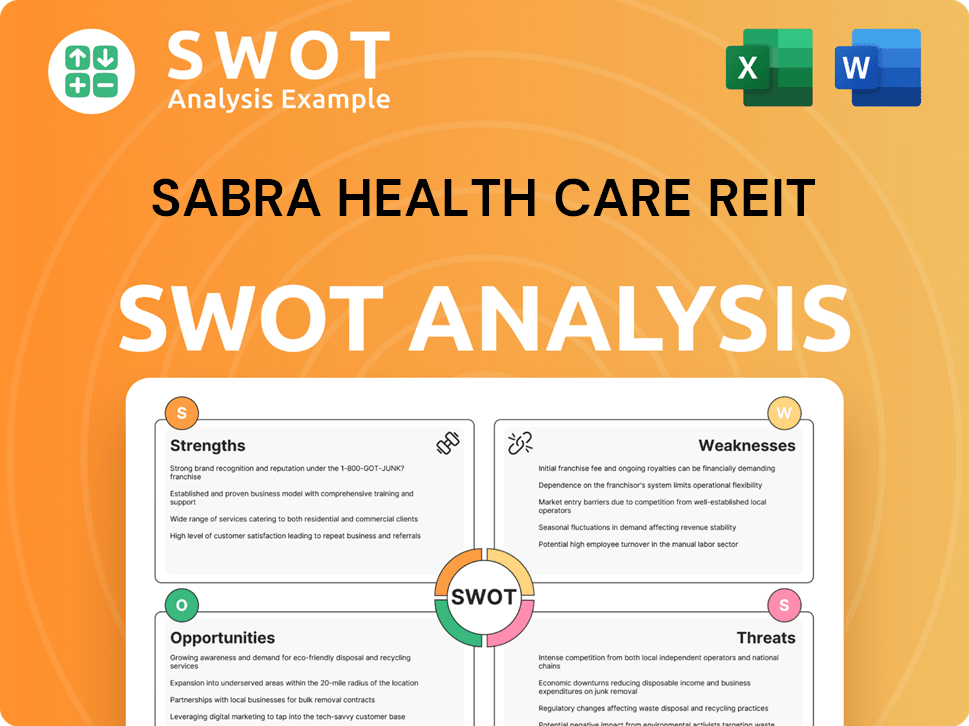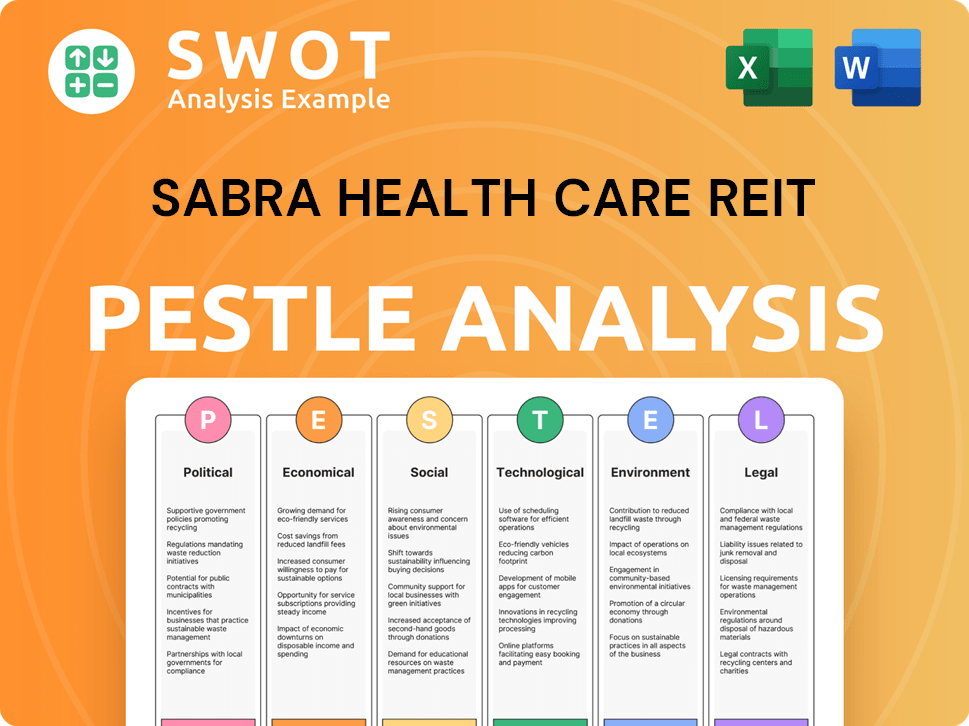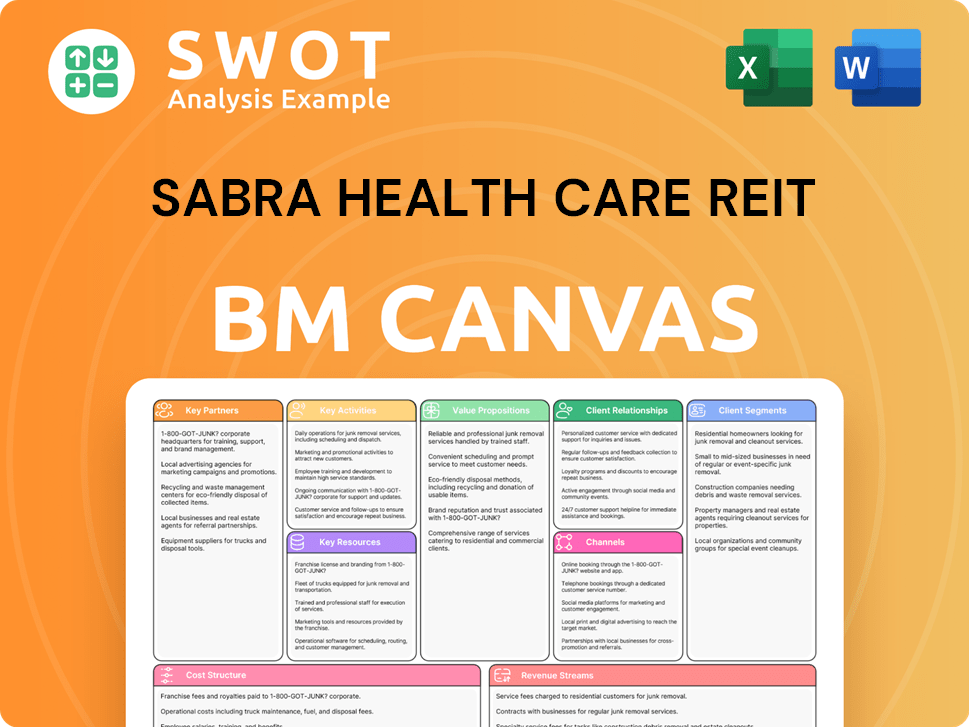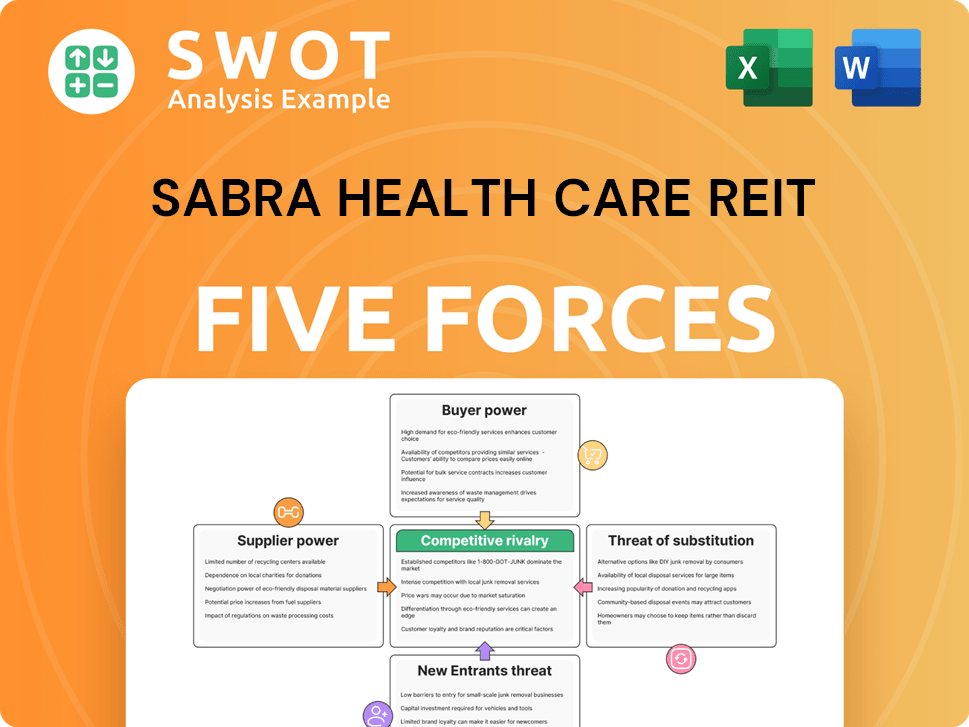Sabra Health Care REIT Bundle
Can Sabra Health Care REIT Maintain Its Competitive Edge?
The healthcare real estate sector is undergoing a significant transformation, fueled by demographic shifts and evolving care models. Within this dynamic environment, understanding the Sabra Health Care REIT SWOT Analysis is crucial for investors and strategists alike. This article dives into the competitive landscape, offering a comprehensive look at Sabra Health Care REIT's position.

This analysis will explore the Competitive Landscape of Sabra Health Care REIT, examining its key rivals and the factors influencing its market share. We'll dissect Sabra's strategic approach, including its investment strategy and portfolio overview, providing insights into its financial performance and industry outlook. Furthermore, we'll compare Sabra Health Care REIT against competitors like Welltower and Healthpeak, offering valuable context for informed decision-making in the Healthcare REIT sector.
Where Does Sabra Health Care REIT’ Stand in the Current Market?
Sabra Health Care REIT holds a prominent position within the healthcare Real Estate Investment Trust (REIT) sector. As of early 2025, its core operations revolve around owning and leasing healthcare properties. The company's portfolio is primarily composed of skilled nursing/transitional care facilities, senior housing, behavioral health facilities, and specialty hospitals. This diverse portfolio allows Sabra to serve a broad spectrum of healthcare operators and patient demographics.
Sabra's value proposition lies in providing capital and real estate solutions to healthcare operators, enabling them to focus on patient care. The company generates revenue through rent and mortgage interest payments from its properties. With a geographic presence mainly in the United States and some investments in Canada, Sabra strategically positions itself to capitalize on the growing demand for healthcare services, particularly from an aging population.
While specific market share figures for individual healthcare REITs can vary, Sabra is recognized as a top-tier healthcare REIT by portfolio size and market capitalization. The company’s strategic focus on a diversified mix of healthcare properties, particularly its significant exposure to skilled nursing and senior housing, positions it to capitalize on the demographic tailwinds of an aging population.
Sabra Health Care REIT's market capitalization places it among the leading healthcare REITs. This financial strength allows for strategic acquisitions and investments. Its strong market position is further supported by its diversified portfolio and focus on key healthcare sectors.
The company's portfolio includes skilled nursing facilities, senior housing, and behavioral health facilities. This diversification helps to mitigate risks associated with specific healthcare sectors. Diversification is a key element of Growth Strategy of Sabra Health Care REIT.
Sabra's financial stability is a key factor in its market standing. The company's balance sheet and access to capital markets support its investment strategy. In its Q4 2024 earnings report, Sabra highlighted its strong liquidity position.
Sabra's primary geographic focus is the United States, with some investments in Canada. This strategic presence allows it to serve a wide range of healthcare operators and patient demographics. This focus supports its competitive position in the Healthcare REIT market.
Sabra's financial performance, including its debt management and liquidity, is crucial for its competitive position. The company's net debt to adjusted EBITDA was 5.3x as of December 31, 2024, demonstrating effective debt management. This financial discipline supports its ability to pursue growth opportunities.
- Strong Liquidity: Supports investment strategy.
- Effective Debt Management: Net debt to adjusted EBITDA of 5.3x as of December 31, 2024.
- Diversified Asset Base: Contributes to a robust market standing.
- Strategic Focus: On key healthcare sectors to capitalize on demographic trends.
Sabra Health Care REIT SWOT Analysis
- Complete SWOT Breakdown
- Fully Customizable
- Editable in Excel & Word
- Professional Formatting
- Investor-Ready Format

Who Are the Main Competitors Challenging Sabra Health Care REIT?
The Competitive Landscape for Sabra Health Care REIT (a Real Estate Investment Trust) is shaped by a mix of direct and indirect competitors. The company's focus on healthcare properties, including Senior Housing and skilled nursing facilities, places it in a sector with significant competition. Understanding these competitors is crucial for evaluating Sabra's market position and potential for growth. For a deeper dive into Sabra's business model, consider reading Revenue Streams & Business Model of Sabra Health Care REIT.
Direct competitors are primarily other publicly traded healthcare REITs. These companies often compete for the same investment opportunities and tenants. Indirect competition comes from a broader range of entities, including private equity firms and institutional investors, who also seek to acquire healthcare properties. This competition can influence acquisition costs and overall profitability.
The competitive dynamics in the healthcare REIT sector are subject to change due to mergers, acquisitions, and shifts in market conditions. These factors can lead to the emergence of larger, more diversified competitors, potentially altering the competitive landscape.
The most significant direct competitors are other publicly traded healthcare REITs. These REITs have similar investment strategies, focusing on healthcare properties.
Ventas is a major player with a diversified portfolio that includes Senior Housing, medical office buildings, and research facilities. As of Q1 2024, Ventas reported a net operating income of $587.7 million. Ventas's market capitalization is generally larger than Sabra's.
Welltower is another significant competitor, with a strong presence in Senior Housing and medical office buildings. Welltower's portfolio is often geographically diverse. In Q1 2024, Welltower reported a net income attributable to common stockholders of $270.9 million.
Omega Healthcare Investors focuses more on skilled nursing facilities, making it a direct competitor in that specific segment. As of May 2024, Omega Healthcare Investors has a market capitalization of approximately $7.7 billion.
These competitors challenge Sabra through their scale, financial resources, and established relationships. Competition involves bidding for properties and securing favorable lease terms.
Indirect competition comes from private equity firms, institutional investors, and other real estate funds. These entities can influence acquisition costs and cap rates.
Sabra's ability to compete depends on factors like property selection, tenant relationships, and financial management. The Competitive Landscape is constantly evolving.
- Scale and Portfolio Diversification: Competitors like Ventas and Welltower often have larger, more diversified portfolios, providing them with more stability.
- Access to Capital: Larger REITs may have easier access to capital markets, giving them an advantage in acquisitions and developments.
- Tenant Relationships: Long-standing relationships with major healthcare operators can provide a competitive edge in securing favorable lease terms.
- Market Specialization: Omega Healthcare Investors' focus on skilled nursing facilities makes it a direct competitor in that sector.
- Acquisition Costs: Private equity firms and other investors can drive up acquisition costs, impacting profitability.
Sabra Health Care REIT PESTLE Analysis
- Covers All 6 PESTLE Categories
- No Research Needed – Save Hours of Work
- Built by Experts, Trusted by Consultants
- Instant Download, Ready to Use
- 100% Editable, Fully Customizable

What Gives Sabra Health Care REIT a Competitive Edge Over Its Rivals?
Understanding the competitive landscape of Sabra Health Care REIT (a Real Estate Investment Trust) is crucial for investors and analysts alike. The company, specializing in healthcare facilities, faces a dynamic market. This analysis delves into Sabra's key competitive advantages, offering insights into its strategic positioning within the healthcare REIT sector.
Sabra Health Care REIT's success hinges on its ability to navigate the complexities of the healthcare real estate market. The company's strategic decisions, portfolio management, and financial strategies are critical to its performance. This chapter examines the elements that set Sabra apart from its competitors, providing a comprehensive view of its strengths and market position.
This exploration of Sabra Health Care REIT's competitive advantages offers a detailed look at the factors that contribute to its success. From its diversified portfolio to its relationships with healthcare operators and financial strategies, this analysis provides a clear understanding of Sabra's strengths in the competitive healthcare REIT market. For a deeper dive into the company's history, consider reading the Brief History of Sabra Health Care REIT.
Sabra Health Care REIT's diversified portfolio across various healthcare property types is a key advantage. This includes investments in skilled nursing facilities, senior housing, and behavioral health facilities. Diversification helps mitigate risks associated with any single property type or healthcare segment. This strategy provides a more stable revenue stream compared to REITs with concentrated portfolios.
The company maintains strong relationships with a diverse group of healthcare operators. Sabra's ability to partner with reputable and financially sound operators is crucial for maintaining high occupancy rates and consistent rental income. Proactive asset management and collaboration with tenants further strengthen these relationships. These relationships contribute to tenant retention.
Sabra's access to capital markets and favorable financing terms provide a competitive edge. This financial flexibility allows the company to pursue strategic acquisitions and invest in property improvements. A disciplined approach to capital allocation, as evidenced by its balance sheet management, supports long-term growth. This financial strength is crucial in the healthcare REIT sector.
Sabra leverages its expertise in underwriting and managing healthcare real estate. This specialized knowledge allows Sabra to identify attractive investment opportunities and manage potential risks effectively. The company's in-depth industry knowledge and regulatory understanding are critical. This expertise is a key differentiator in the competitive landscape.
Sabra Health Care REIT's competitive advantages include a diversified portfolio, strong operator relationships, financial flexibility, and specialized expertise. These elements contribute to its ability to navigate the complexities of the healthcare REIT market. These strengths position Sabra well in the competitive landscape.
- Diversified Portfolio: Investments across various healthcare property types mitigate risks.
- Strong Operator Relationships: Partnerships with reputable operators ensure high occupancy rates.
- Financial Flexibility: Access to capital markets supports strategic acquisitions.
- Specialized Expertise: In-depth industry knowledge allows for effective risk management.
Sabra Health Care REIT Business Model Canvas
- Complete 9-Block Business Model Canvas
- Effortlessly Communicate Your Business Strategy
- Investor-Ready BMC Format
- 100% Editable and Customizable
- Clear and Structured Layout

What Industry Trends Are Reshaping Sabra Health Care REIT’s Competitive Landscape?
The healthcare real estate sector, where Sabra Health Care REIT operates, is influenced by several key trends. These trends present both opportunities and challenges for the Real Estate Investment Trust (REIT). Understanding the competitive landscape is crucial for investors and stakeholders alike. The aging global population, technological advancements, and regulatory changes significantly shape the industry.
Sabra Health Care REIT faces risks related to operator performance, reimbursement rates, and labor costs. However, it also has opportunities in specialized healthcare services and strategic partnerships. The financial performance of Sabra Health Care REIT is directly tied to the health and stability of its tenants, which in turn, is affected by these broader industry dynamics. For more information about the company, check out Owners & Shareholders of Sabra Health Care REIT.
The aging population is a primary driver, increasing demand for Senior Housing and skilled nursing facilities. Technological advancements, such as telehealth, are changing care delivery. Regulatory changes, particularly in Medicare and Medicaid, influence reimbursement rates and tenant financial health.
Rising labor costs and staffing shortages in healthcare pose challenges for operators. Fluctuations in reimbursement rates can impact tenant financial stability. Adapting to evolving care models and technological advancements requires strategic investment.
Expanding into specialized healthcare services like behavioral health offers growth potential. Strategic partnerships with innovative providers can unlock value. Redeveloping existing properties to meet modern standards is another avenue for growth.
Sabra Health Care REIT is likely to focus on portfolio diversification and proactive asset management. Maintaining strong relationships with operators is critical. The company may seek opportunities to invest in emerging healthcare property types and markets.
Sabra Health Care REIT must navigate the evolving healthcare landscape. This includes managing risks related to operator performance and adapting to technological changes. The company's success depends on its ability to capitalize on growth opportunities.
- Diversifying the portfolio to reduce risk.
- Proactive asset management to optimize property performance.
- Strategic partnerships to access new markets and technologies.
- Maintaining financial flexibility to adapt to market changes.
Sabra Health Care REIT Porter's Five Forces Analysis
- Covers All 5 Competitive Forces in Detail
- Structured for Consultants, Students, and Founders
- 100% Editable in Microsoft Word & Excel
- Instant Digital Download – Use Immediately
- Compatible with Mac & PC – Fully Unlocked

Related Blogs
- What are Mission Vision & Core Values of Sabra Health Care REIT Company?
- What is Growth Strategy and Future Prospects of Sabra Health Care REIT Company?
- How Does Sabra Health Care REIT Company Work?
- What is Sales and Marketing Strategy of Sabra Health Care REIT Company?
- What is Brief History of Sabra Health Care REIT Company?
- Who Owns Sabra Health Care REIT Company?
- What is Customer Demographics and Target Market of Sabra Health Care REIT Company?
Disclaimer
All information, articles, and product details provided on this website are for general informational and educational purposes only. We do not claim any ownership over, nor do we intend to infringe upon, any trademarks, copyrights, logos, brand names, or other intellectual property mentioned or depicted on this site. Such intellectual property remains the property of its respective owners, and any references here are made solely for identification or informational purposes, without implying any affiliation, endorsement, or partnership.
We make no representations or warranties, express or implied, regarding the accuracy, completeness, or suitability of any content or products presented. Nothing on this website should be construed as legal, tax, investment, financial, medical, or other professional advice. In addition, no part of this site—including articles or product references—constitutes a solicitation, recommendation, endorsement, advertisement, or offer to buy or sell any securities, franchises, or other financial instruments, particularly in jurisdictions where such activity would be unlawful.
All content is of a general nature and may not address the specific circumstances of any individual or entity. It is not a substitute for professional advice or services. Any actions you take based on the information provided here are strictly at your own risk. You accept full responsibility for any decisions or outcomes arising from your use of this website and agree to release us from any liability in connection with your use of, or reliance upon, the content or products found herein.